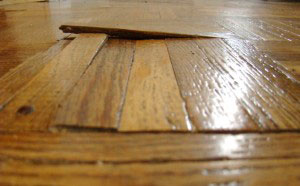Oct 07, 2013

Hardwood floors are a common flooring choice for homeowners, as they are incredibly strong and add a level of elegance to any household. However, snap, crackle and pop are not words you want to associate with your hardwood floors. Floors are typically attached to the floor joists below with nails. Over time, the wood and nails may loosen and cause popping noises while you walk on them. This can be an annoying issue that may devalue your hardwood floors. To fix this problem, you can strategically find the particular wood floor panel that is popping and directly attach it to the floor joist with new nails. Follow the simple steps below to stop the pop!
What you will need:
- A safe release masking tape
- Deep-scanning stud finder with metal scanning mode
- Power drill
- 10-penny finish nail
- Hammer
First, locate the popping portion of the wood floor by slowly walking across it. Press a piece of masking tape to the floor to mark the popping spot.
Next, scan the area surrounding the marked spot using a deep-scanning stud finder. Locate the floor joist that supports that particular wood panel. Depending on the construction of the home, the joist will either run parallel or perpendicular to the nearest wall.
Next, locate the center of the popping wood panel that is directly above the found floor joist. Drill a hole that is smaller than a 10-penny finish nail into the panel’s center point with a power drill. This tiny hole will prevent you from splitting the panel in half.
Now, place a 10-penny finish nail into the drilled hole. Strike the nail with a hammer to affix the wood panel to the lower floor joist. This process should take some strength since the floor joist is extremely dense. The nail’s head should be below the wood’s surface.
Finally, squeeze wood-colored filler putty onto the nail’s head. Leave adequate time to allow the putty to dry.
Make sure you walk around the repaired area to verify that the popping noise has abated and do not install more than one nail in the same floor panel area. Clustering nails together can cause splitting in the hardwood structure.
Tip: If you do not have a deep-scanning stud finder, you can locate the floor joists by scanning the floor for top nails. They will be covered with putty and located every 16 to 20 inches along the floor’s surface and denote the location and orientation of the floor joist below.
These tips are also recommended by Amy Rodriguez, a professional writer from the San Fransisco Bay Area News. Follow SFGate on Facebook!